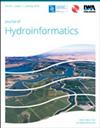Impact of the model structure and calibration strategy on baseflow modeling in the German low mountain range
IF 2.2
3区 工程技术
Q3 COMPUTER SCIENCE, INTERDISCIPLINARY APPLICATIONS
引用次数: 0
Abstract
Baseflow is a vital component of the water balance. The fractured hard rock aquifers of the German low mountain range are in danger of increased water stress due to climate change because they react rapidly to deficits in precipitation and groundwater tables decline sharply. Therefore, simulation software must be able to model baseflow accurately. Three soil moisture simulation and two monthly factor-based baseflow models are evaluated using two calibration strategies. Models were calibrated to total flow (S1) or stepwise to baseflow and then total flow (S2). Results were not significantly different for total flow. Regarding baseflow, S2 proved significantly better with median values (S1 calibration, validation | S2 calibration, validation) of SSE (20.3, 20.3 | 13.5, 13.8), LnNSE (0.15, 0.17 | 0.47, 0.34), and PBIAS (27.8, 21.6 | 2.5, −0.8). Parallel linear reservoir proved best at modeling baseflow with a median SSE (S2: 6.1, 5.9), LnNSE (S2: 0.64, 0.71), and PBIAS (S2: 3.8, 3.8). The new modified monthly factor approach is a simple and robust alternative with SSE (13.0, 13.3), LnNSE (0.61, 0.61), and PBIAS (9.8, −8.6). The results are useful regarding selection of baseflow model structure and calibration strategy in low mountain ranges with fractured hard rock aquifers.模型结构和校准策略对德国低山岭基流模型的影响
基流是水量平衡的重要组成部分。德国低山丘陵地区的断裂硬岩含水层对降水不足反应迅速,地下水位急剧下降,因此有可能因气候变化而加剧水资源紧张。因此,模拟软件必须能够准确模拟基流。采用两种校准策略对三种土壤水分模拟模型和两种基于月因子的基流模型进行了评估。模型校准为总流量(S1)或先校准为基流再校准为总流量(S2)。总流量的校核结果差异不大。在基流方面,S2 的中值(S1 校准、验证 | S2 校准、验证)SSE(20.3,20.3 | 13.5,13.8)、LnNSE(0.15,0.17 | 0.47,0.34)和 PBIAS(27.8,21.6 | 2.5,-0.8)明显更好。平行线性水库的基流建模效果最好,其中位数为 SSE(S2:6.1,5.9)、LnNSE(S2:0.64,0.71)和 PBIAS(S2:3.8,3.8)。新的修正月度因子法是一种简单而稳健的替代方法,其上限值(13.0,13.3)、LnNSE(0.61,0.61)和 PBIAS(9.8,-8.6)。这些结果有助于在有断裂硬岩含水层的低山岭地区选择基流模型结构和校准策略。
本文章由计算机程序翻译,如有差异,请以英文原文为准。
求助全文
约1分钟内获得全文
求助全文
来源期刊

Journal of Hydroinformatics
工程技术-工程:土木
CiteScore
4.80
自引率
3.70%
发文量
59
审稿时长
3 months
期刊介绍:
Journal of Hydroinformatics is a peer-reviewed journal devoted to the application of information technology in the widest sense to problems of the aquatic environment. It promotes Hydroinformatics as a cross-disciplinary field of study, combining technological, human-sociological and more general environmental interests, including an ethical perspective.
 求助内容:
求助内容: 应助结果提醒方式:
应助结果提醒方式:


